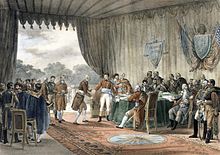- Convention of 1800
-
The Convention of 1800, 8 Stat. 178, also known as the Treaty of Mortefontaine, was a treaty between the United States of America and France to settle the hostilities that had erupted during the Quasi-War. The Quasi-War, waged primarily in the Caribbean, had existed since the American delegation to France, arriving in 1797, had been told that America had to pay $250,000 to see—not negotiate with—the French ambassador. This incident, known as the XYZ Affair, was scandalous in America, infuriating both the Hamiltonians (Federalists) and the Jeffersonians. French warships seized American merchant ships in the Caribbean, and American privateers retaliated against French shipping.
By 1800, both sides wanted the incident buried, and so the end of hostilities in the Caribbean generally proceeded as smoothly as the end of the French-American alliance. The French, at the time, were at war with Britain and did not want the neutral United States drawn in on either side; a belligerent America allied with France would be quickly crushed by the British navy while a neutral America would be able to supply the French with desperately needed grain. The United States, for the same reasons, wished to remain neutral. Since both parties had the same goal in mind, the Convention of 1800 resulted in a peaceful cessation of the alliance between the two countries (the alliance had no "expiration date" built in, so waiting until the alliance dissolved itself was impossible). U.S. President John Adams sent a commission composed of William Vans Murray, Oliver Ellsworth, and William Richardson Davie to negotiate the agreement.
The Convention of 1800 terminated the only formal treaty of alliance the United States had signed; it would be nearly a century and a half before the United States entered into another formal alliance.[1] This decision was strongly influenced by George Washington's 'farewell address' of four years earlier, together with new President John Adams' strongly independent foreign policy stance, particularly regarding European colonial powers.
Depredations against American shipping committed by the French during the Quasi-War led to claims against France that were relinquished by the terms of the Treaty. Since the claims against France were no longer valid, claimants continually petitioned Congress for the relief that had been waived. It was not until January 20, 1885 that a law was passed, 23 Stat. 283, that provided for consideration of the matter before the United States Court of Claims. The lead case, Gray v. United States, 21 Ct. Cl. 340, was decided May 17, 1886 in favor of the plaintiff, with the recommendation that Congress pay the claim. The cases continued in the court until 1915.
Convention of 1800
The Convention of 1800 established, among other things:
- That "[t]here shall be a firm, inviolable, and universal peace, and a true and sincere Friendship between the French Republic, and the United States of America" (Article I).
- That all prior agreements between the two countries concerning alliance and mutual trade were no longer operative (Article II).
- That each was to return public ships captured in the war (Article III).
- The free passage for all goods (except materiel to declared enemies) and passports (several articles).
- That each nation was to give the other the equivalent of "Most Favored Nation" trade status (Articles VI, X, and XI).
- That in the case of future wars between the countries, merchants and citizens would have six months to remove themselves and dispose of their assets in the other country. Individuals' assets would not be frozen in future conflicts (Articles VIII and IX).
- That privateers would have to enter sureties to cover any unlawful damage inflicted in the future (in modern terms, they would have to carry insurance) (Article XXIII).
- That French fishing rights off Newfoundland and the Gulf of Saint Lawrence were to be guaranteed (Article XXVII).
The treaty was officially signed on September 30, 1800, and was proclaimed after being ratified by both countries on December 21, 1801.
Notes
References
- Avalon Project - Text of Treaty
- Cowen, Wilson; Philip Nichols, Jr., and Marion T. Bennett (1978). The United States Court of Claims: A History; Part II: Origin, Development, Jurisdiction, 1855–1978. Washington, D.C.: Committee on the Bicentennial of Independence and the Constitution of the Judicial Conference of the United States.
Categories:- Quasi-War
- Treaties of the United States
- 1800 in France
- 1800 in the United States
- 1800 treaties
- Treaties of the French First Republic
Wikimedia Foundation. 2010.

